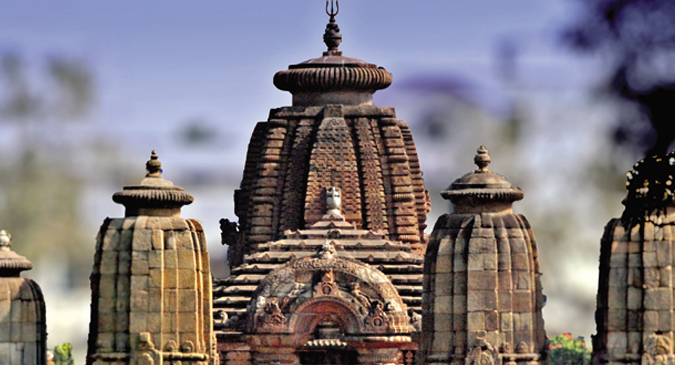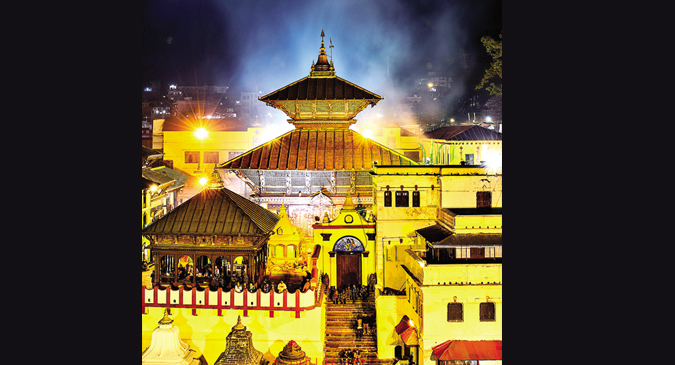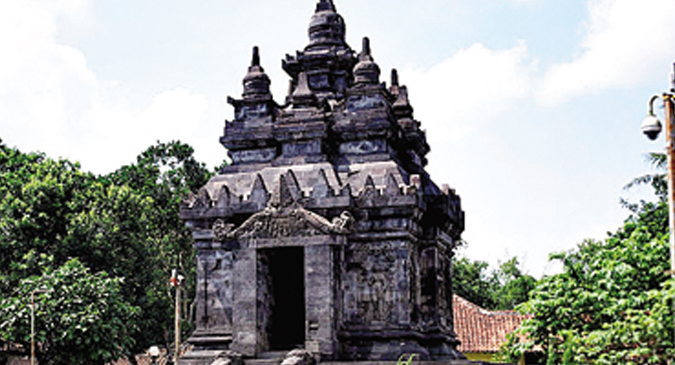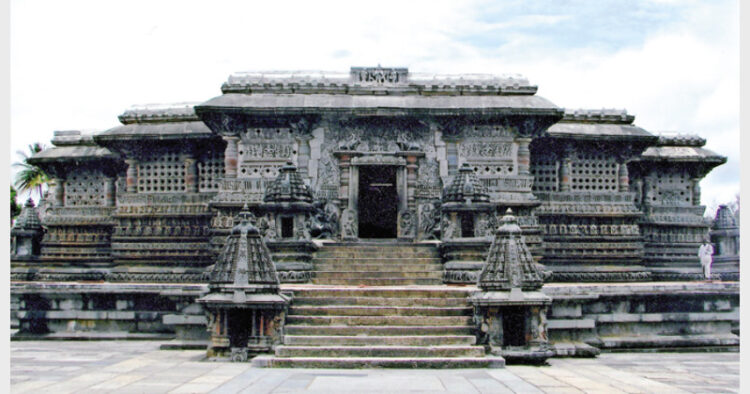The ancient land of Bharatvarsha is not only epitomised in the beauty of its magnificent temples and majestic gopuras, it is also enshrined in the strict adherence of its vedic traditions. The author takes a look at the sorry state of our glorious temple, in the light of brazen attacks by ungodly regimes on Sabarimala shrine
Aabhas K Maldahiyar
Bharat is a godless land. Yet, it has innumerable gods and goddesses. This paradoxical idea is beautifully captured by the ‘Republic of Temples’. Bharatavarsh is a land of divinity with a delightful diversity that has amazingly come together to shape the Republic. While its diversity is tied to the legal framework of the Constitution, the Hindu culture is irretrievably tied to its temple traditions. It may appear to be distinct on the surface but if you scratch the surface and go a bit deep, it only leaves us dumbstruck.

Chennakeshava Temple at Belur
Temple tradition forms the very core of our civilisation. Indeed, it is the very thread of Hindu tradition that has kept our civilisation alive, despite thousands of years of oppression and foreign invasions. Forces in post-Independence India that have become significant are trying to eschew Hinduism’s ancient tradition. Our worst shame has been our tendency to ignore our temple traditions in the absence of a Vedic realm.
How Ancient are Our Temples?
India has had highly skilled artists and architects to create art, architecture, craft etc. Priot to the Indus Valley Civilisation, it is claimed by both Indian and Western scholars that temples came into being in ancient Bharatavarsh around 100 B.C. Their assumptions and conclusions are founded on shaky evidence and sometimes outright falsehood.
The whole argument revolves around the date of the Rig Veda. The Rig Veda contains many references to images and the ‘houses’ of images. If the Rig Veda is accurately dated, the beginning of image worship and temple building in Vedic India can be reasonably fixed. Astronomical evidence proves that the earliest Rig Vedic compositions date back to at least the sixth millennium B.C.

Nagara style of temple architecture : Mukteshvara Temple, Odisha
KC Verma points out that Lokmanya Tilak and Hermann Jacobi, ‘established that the Vedic period commences in 4500 B.C., and that the bulk of the hymns of the Rig Veda were composed between 3500 B.C. and 2500 B.C., when the vernal equinox was in the Orion (4500-3500 B.C.) and later receded (3500-2500 B.C.) to Rohini; the Krittika period during which the Vedas and the Upanishads were composed extended from 2500-800 B.C. They have been supported on independent grounds by PC Sengupta, in his Ancient Indian Chronology, 1947. He adds, “No one, to the best of my knowledge, has so far been able to refute the arguments advanced by these scholars.”
In the same book, Sengupta has also shown that the solar eclipse in the Rig Veda. V 40.5-9 took place on July 26, 3928 BC and the beginnings of the Vedic literature he traces to 3500 B.C. Some scholars have tried to brand the astronomical statements given in the Vedic literature as ‘fabrications’ based on astronomical back calculations. This would mean that the ancient Indians deliberately doctored their hymns to fool future astronomers! The very idea is ridiculous. John Playfair, astronomer, physicist and mathematician, in the Edinburgh Review, shows that the Indian Zodiac originated in 4300 B.C. and rejects any idea of Rig Vedic astronomical statements as being fabrications.

Pashupatinath Temple in Nepal
Vedic scholar David Frawley basing his calculations on astronomical references in the Rig Veda takes the creation of the Rig Vedic hymns even further back. ‘…the original story of Surya Savitri, the Sun Goddess, in the Rig Veda reflects the Ashwini era of the winter solstice, and thereby a date of at least 6000 B.C. when the winter solstice was in Aries, possibly as early as 7000 B.C when the solstice first entered Ashwini.’
Frawley sums up his discussion, ‘With such astronomical references in all Vedic texts, on what grounds can we deny them? If the Rig Veda uses the same terms as later astronomy, we cannot say they are wrong or referred to something else because it does not agree with our theories. Our theories may be wrong but the stars are not.
According to the stars then I would give these dates for Vedic texts:
1. Proto-Rig Vedic : before 6000 B.C.
2. Early-Rig Vedic : 6000-4000 B.C.
3. Later Rig Vedic/Four Veda period : 4000-2000 B.C.
4. Transitional Vedic Period: 2000-1000 B.C.
Thus a rapidly growing body of scholars now refutes earlier dates for the Rig Veda. In fact, some scholars doubt the existence of images and their use in the Rig Veda. Bodwing, however, writes, “The existence of images in Vedic times has been proved by Dr. Bollensen in the cases of a painted image of Rudra, of Varuna, with a golden coat of mail in the distinction drawn between the Mruts and their images of God having the form of men.” He continues, “From the appellation of the Gods as deva-naras (God-humans)… we may conclude that the Indians did not assign merely in imagination human forms to their Gods but also represented them in a sensible manner.”

Historians dubbed Pawon Temple as ‘The Jewel of Javanese Architecture’
The Shatpath Brahmana, which has been dated 3500 BC, contains the following dialogue. A question is asked, “Why should an image made of clay be used in worshipping?” The answer: “If the image is made of wood it will catch fire during the Worship. If it is of stone it will split. If made of metal it will become hot and burn things around it…”
Such references abound in Vedic literature and point to an established mode of image worship. David Frawley argues, “Certainly many great artists and craftsmen are mentioned in the Rig Veda, like the Ribhus, working in gold, bronze, stone, and wood. This shows that the craftsmanship to do such work (image making) existed… the Rig Veda does not uncommonly mention houses of worship and places of public assembly (sabha, samiti).” Vashishta, one of the most well-known of the Vedic sages, enters the vast mansion, the thousand-doored house of the God Varuna (Rig Veda VII. 88.5)… Other hymns to Mitra and Varuna indicate a temple of a thousand pillars made of bronze or gold (Rig Veda II. 41.5./V.62.6-8) Later, Hindu temples were often made in the form of chariots (rathas). As the chariot is very prominent in Vedic texts, perhaps even in these it may have referred to temples of that form. He further says, “To whatever the degree they have been used, temples and icons were not outside the mentality of the Vedic religion… along with the cities…”
Assuming that the dating of Rig Veda mentioned here is as suggested by current scholarship, image worship and temples will have been most probably the first in the history of the world. Vedic man worshipped the God as he saw in nature and sang hymns, preserved in the Rig Veda, in His Glory.
The Varied Nomenclature
In Sanskrit, the word mandir means ‘house’ (Sanskrit ). Ancient Sanskrit texts use many words for temple, such as matha, vayuna, kirti, kesapaksha, devavasatha, vihara, suravasa, surakula, devatayatana, amaragara, devakula, devagrha, devabhavana, devakulika, and niketana. Regionally, they are also known as prasada, vimana, kshetra, gudi, ambalam, punyakshetram, deval, deula, devasthanam, kovil, candi, pura, and wat.
The following are the other names by which a temple is referred to in India:
- Devasthana in Kannada
- Deul/Doul/Dewaaloy in Assamese and in Bengali
- Deval/Raul/Mandir in Marathi
- Devro/Mindar in Rajasthani
- Deula/Mandira in Odia and Gudi in Kosali Odia
- Gudi, Devalayam , Devasthanam, Kovela, Kshetralayam, Punyakshetram, or Punyakshetralayam, Mandiramu in Telugu
- Kovil or k?-vill and occasionally Aalayam in Tamil; the Tamil word Kovil means “residence of God”
- Kshetram, Ambalam, or Kovilin Malayalam
- Mandir in Hindi, Nepali, Kashmiri, Marathi, Punjabi, Gujarati, and Urdu
- Mondir in Bengali
In Southeast Asia temples known as:
- Candi in Indonesia, especially in Javanese, Malay and Indonesian.
- Pura in the Island of Bali, Indonesia.
- Wat in Cambodia and Thailand
Varied Architecture Nagara Architecture North Indian temples are referred to as Nagara style of temple architecture. They have sanctum sanctorum where the deity is present, open on one side from where devotees are offered darshan. There may or may not be many more surrounding corridors, halls, etc. However, there will be space for devotees to go around the temple for clockwise circumambulation. In North Indian temples, the tallest towers are built over the sanctum sanctorum in which the deity is installed.
The Nagara style of temple designs in North India often deploy fractal-theme, where smaller parts of the temple are themselves images or geometric re-arrangement of the large temple. Hindu temple structures deploy this principle in every dimension with garbhgriya as the primary locus, and each pada as well as zones serving as additional centres of loci. This makes Nagara Hindu temple architecture symbolically a perennial expression of movement and time, of centrifugal growth fused with the idea of unity in everything.
Temples in West Bengal
Bengali terra cotta temple architecture is found in West-Bengal. Due to lack of suitable stone in the alluvial soil locally available, the temple makers had to resort to other materials instead of stone. This gave rise to using terracotta as a medium for temple construction. Terracotta exteriors with rich carvings are a unique feature of Bengali temples. The town of Vishnupur in West Bengal is renowned for this type of architecture. There is also a popular style of building known as Navaratna (nine-towered) or Pancharatna (five-towered). An example of Navaratna style is the Dakshineswar Kali Temple.
Temples in Odisha
Odisha temple architecture is known as Kalinga architecture, classifies the spire into three parts, the B??a (lower limb), the Gan?i (body) and the Cu?a/Mastaka (head). Each part is decorated in a different manner. Kalinga architecture is a style which flourished during the Kalinga rule in ancient Odisha. It includes three styles: Rekha Deula, Pidha Deula and Khakhara Deula. The former two are associated with Vishnu, Surya and Shiva temples while the third is mainly associated with Chamunda and Durga temples. The Rekha Deula and Khakhara Deula house the sanctum sanctorum while the Pidha Deula style includes space for outer dancing and offering halls.
The Goan Temples
The temple architecture of Goa is quite unique. As Portuguese colonial hegemony increased, Goa’s Hindu temples became a rallying point for local resistance. Goan temples were built using sedimentary rocks, wood, limestone and clay tiles, and copper sheets were used for the roofs. These temples were decorated with mural art called as Kavi kala or ocher art. The interiors have murals and wood carvings depicting scenes from the Hindu Itihasa.
South Indian and Sri Lankan Temples
South Indian temples sport very large gopuram – tower – usually very ornate, at the entrance of the temple. This forms a prominent feature of kovils, the South Indian Hindu temples. They are topped by a kalasam, a stone finial. They function as gateways through the walls that surround the temple complex. The gopuram’s origins can be traced back to early structures of the Tamil kings Pallavas; and by the twelfth century, under the Pandya rulers, these gateways became a dominant feature of a temple’s outer appearance, eventually overshadowing the inner sanctuary which became obscured from view by the gopuram’s colossal size. It also dominated the inner sanctum in amount of ornamentation. Often a shrine may have more than one gopuram. They also appear in architecture outside India, especially in Khmer architecture, as on Angkor Wat. A kovil or koil may have multiple gopurams, typically constructed into multiple walls in tiers around the main shrine. The temple’s walls are typically square with the outer most walls having gopurams. The sanctum sanctorum and its towering roof (the central deity’s shrine) are also called the vimanam. The inner sanctum has restricted access with only the priests allowed beyond a certain point.
Temples in Cambodia
Angkor Wat was built as a Hindu temple by King Suryavarman II in the early 12th century in Yasodharapura (Khmer, present-day Angkor), the capital of the Khmer Empire, as his state temple and eventual mausoleum. Breaking from the Shaiva tradition of previous kings, Angkor Wat was instead dedicated to Vishnu. The Spire in Khmer Hindu temple is called Giri (mountain) and symbolizes the residence of gods just like Meru does in Bali Hindu Itihasa and Ku (Guha) does in Burmese Hindu folklore. Angkor Wat is just one of numerous Hindu temples in Cambodia, most of them in ruins. Hundreds of Hindu temples are scattered from Siem Reap to Sambor Prei Kuk in central Cambodian region.
Temples in Nepal
Pashupatinath temple is one of the important temples of Hindu religion which is situated in Kathmandu; Nepal. It is built in a pagoda style and is surrounded by hundreds of temples and buildings built by kings. The temples top is made from pure gold.
Temples in Vietnam
There are a number of Hindu temple clusters along the coast of Vietnam, with some on UNESCO world heritage site list. Examples include M? S?n – a cluster of 70 temples with earliest dated to be from the 4th century AD and dedicated to Siva, while others are dedicated to Hindu deities Krishna, Vishnu and others. These temples, internally and with respect to each other, are also built on the Hindu perfect square grid concept. Other sites in Vietnam with Hindu temples include Phan Rang with the Cham temple Po Klong Garai.
Temples in Indonesia
Ancient Hindu temples in Indonesia are called Candi (read chandi). Hindu temples of ancient Java bear resemblances with temples of South Indian style. The largest of these is the 9th century Javanese Hindu temple, Prambanan in Yogyakarta, now a UNESCO world heritage site. It was designed as three concentric squares and has 224 temples. The inner square contains 16 temples dedicated to major Hindu deities, of which Shiva temple is the largest. The temple has extensive wall reliefs and carvings illustrating the stories from the Hindu epic Ramayana.
In Bali, the Hindu temple is known as “Pura”, which is designed as an open-air worship place in a walled compound. The compound walls have a series of intricately decorated gates without doors for the devotee to enter. The design, plan and layout of the holy pura follow a square layout.
Temples in Thailand
Thailand has many notable Hindu temples including: the Sri Mariammam temple in Bangkok, the Devasathan, the Erawan Shrine, Prasat Muang Tam, Sdok Kok Thom and Phanom Rung. Most of the newer Hindu temples are of South Indian origin and were built by Tamil migrant communities. However, Thailand has many historic indigenous Hindu temples such as Phanom Rung. Although most indigenous Hindu temples are ruins, a few such as Devasathan in Bangkok are actively used.
The Axis of Plurality
Based on the varied geographical and cultural pretext, we have varying styles of temples both in architecture and traditions. But the common thread of Vedic realm has always kept them united as a republic. Every temple rises in the wake of Vedic Richas. Every tradition though with difference finds roots in Vedas directly or indirectly: at times through Puranas, at times through Itihasas and at times through Brahmanas etc. Wherever you go, the rituals may seem varying but carry the core values. The ultimate goal of every tradition lays in attainment of Parama Brahma though Yogic Karmas.
The Need
If you had noted my opening remarks in the article, I mentioned Bharat as being a godless land but with multiple gods. The seemingly contrary or paradoxical statement is that the Hindu idea never perceives God as an entity from heaven but anyone around may be a God. We evoke God in stones and even in human beings. The temple is such a place which carries the vibes of rituals centered on the invoked personified deity. The traditions embed but the Sanskaras.
When inside the temple, devotees keep both hands folded (namaste mudra). The inner sanctuary, where the murtis reside, is known as the garbhagriha. It symbolises the birthplace of the universe, the meeting place of the gods and humans, and the threshold between the transcendental and the phenomenal worlds. It is in this inner shrine that devotees offer their prayers.
With the passage of time, the idea of Sanskrit phobia has erased the recital of Veda Mantras. The Mantras alike traditions are being regionalised and hence we are losing out the glue that once bound the varying traditions together under one republic. Of late, there have been various attacks on Temple Traditions as well. The latest attack on Sabrimala temple tradition is the most blatant and outrageous one. Post-modernists debated temple traditions on the grounds of gender discrimination, though the case had to do with ancient traditions. A sanatani temple is certainly not the place where you worship someone who is believed to be sitting somewhere in heaven but is about celebration of traditions. The traditions once broken do breach the philosophical make of the temple.
It is time for urgent intervention. If not intervened we will soon lose the Vedic values and traditions. As of now people hardly understand and are aware of the core reasons of the traditional values. Nothing but the preservation or observance of the temple traditions and the great ‘Republic of Temples’ can save the Sanatan Dharma.
(The writer is Bengaluru-based author and columnist)













Comments